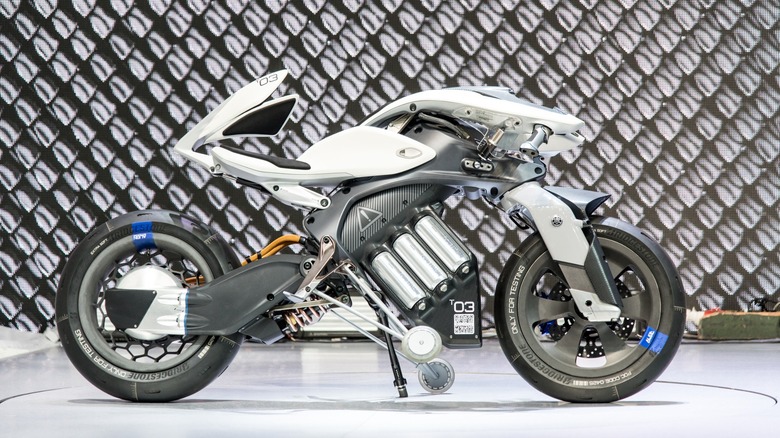If you’ve ever been behind the handlebars of a motorcycle, you know that some balance is required. At higher speeds, you can cruise along and let the bike’s centrifugal force keep you upright. The moment you slow down to a crawl, though, you’ll at some point have to put a foot on the ground to stabilize. In 2017, Honda introduced an idea that could one day change that by revealing a new concept that could revolutionize the industry.
During the Consumer Electronics Show (CES) in Las Vegas, Honda pulled back the curtain on its «Riding Assist Technology.» The demonstration showed a rider standing tall on a Honda bike, both feet on the foot pegs, and arms fully stretched while Honda’s Rider Assist Technology kept the bike from tipping over.
The prototype borrowed from Honda’s UNI-CUB personal mobility device. Skirting some of the heavier technology that other self-balancing motorcycle concepts used, the Honda Riding Assist Motorcycle keeps itself upright without gyroscopes. It was impressive to see in 2017 and remains so years later. However, since CES 2017, other manufacturers have stepped forward with their own self-balancing motorcycle concepts, each one tweaking how they keep rides from toppling over.
How do self-balancing motorcycles work?
Honda’s version of the self-balancing motorcycle takes the conventions of a standard bike and flips them. Bikes typically lean toward the direction of the front wheel, hence why you’re advised to point the front wheel in the direction you want the bike to go. With Honda’s Riding Assist Technology, the motorcycle will actually lean away from the direction of the front wheel.
At the center of this technology is a mechanism that alters the angle of the front fork, which connects the front wheel to the handlebars. When the bike drops to slower speeds, the fork’s angle is adjusted to keep the bike moving in a relatively straight line. Rapid, small adjustments are made to stabilize the bike as it creeps forward.
Six years after Honda’s reveal, Yamaha produced a concept for its own self-balancing bike. Like the Riding Assist Technology, Yamaha’s Advanced Motorcycle Stabilization Assist System (AMSAS) foregoes a gyroscope and instead uses the six-axis Inertial Measurement Unit (IMU) and a pair of actuators to make the necessary adjustments to keep the bike balanced. AMSAS kicks in both when slowing to a stop and during initial acceleration.
Is self-balancing the same as self-driving?

Yimmyphotography/Shutterstock
If you do any sort of research on self-balancing motorcycles, chances are you’ll come across what BMW Motorrad describes as a self-driving motorcycle. Not to be confused with Honda or Yamaha’s self-balancing bikes, the self-driving iteration keeps the bike from falling over while also keeping it in motion.
Revealed more than a year after Honda’s CES innovation, BMW’s self-driving bike isn’t meant to be a production model. Instead, the manufacturer wants to use some of the technology as it is perfected to provide riders with a more stable experience on future models. The hope is to implement safety features akin to modern cars and cut down on the risk of avoidable accidents. Unfortunately, the same safety features used in cars aren’t as viable in motorcycles, where a user can lose their balance in the event of a sudden and unexpected stop.
In 2017, Yamaha also unveiled another self-driving concept bike called the Motoroid. Six years later, it unveiled the Motoroid 2, a handlebar-free bike that uses gyroscopes and AI to navigate and stay upright. While the original Motoroid was merely a concept, Yamaha built a working prototype of the Motoroid 2. Plans for a production model were not yet revealed as of this writing.
Can you purchase a self-balancing motorcycle?
Currently, neither Honda nor Yamaha have released their self-driving motorcycles for public purchase. In fact, neither has produced more than the original concept bikes. However, that’s not to say something isn’t on the horizon, especially after Lit Motors started taking preorders on its self-balancing motorcycle. Although the manufacturer describes the vehicle as an autonomous-balancing electric vehicle (AEV) and not a motorcycle, it does note that it has the «romance & efficiency» of one while touting the «comfort & safety of a car.»
The AEV is essentially a fully enclosed bike that’s capable of self-balancing by «transferring roll moments to the gyros, not the occupants,» according to Lit Motors. A step up from motorcycles, the AEV comes with seatbelts and multi-point airbags for added safety. The current model, which is available for pre-order, takes anywhere from four to eight hours to charge, can seat two adults, features a steering wheel instead of handlebars, and runs at 14 miles per kWh. As of this writing, the manufacturer estimated the vehicle’s MSRP to be $32,000, although that might change once it actually goes on the market.